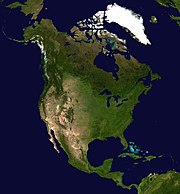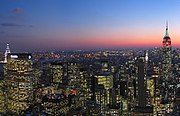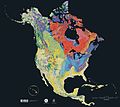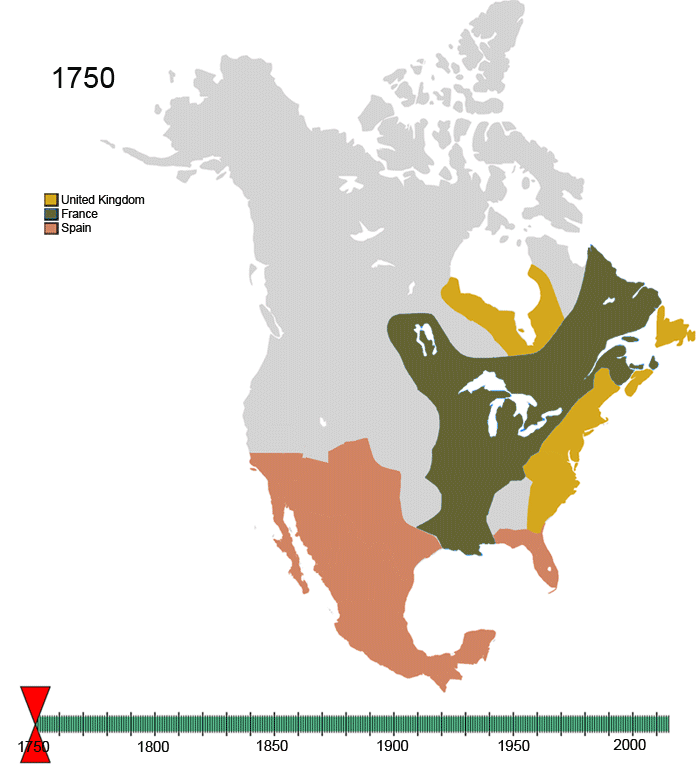North America
| Area | 24,709,000 km² (9,540,000 sq mi) |
|---|---|
| Population | 528,720,588 (July 2008 est.) |
| Density | 22.9/km² (59.3/sq mi)[1] |
| Countries | 23 |
| Dependencies | 18 |
| Demonym | North American |
| Languages | English, Spanish, French, and many others |
| Time Zones | UTC (Danmarkshavn, Greenland) to UTC -10:00 (west Aleutians) |
| Largest urban agglomerations (2005) | Mexico City New York City Los Angeles Chicago Miami more…[2] |
North America is the northern continent of the Americas,[3] situated in the Earth's northern hemisphere and almost totally in the western hemisphere. It is bordered on the north by the Arctic Ocean, on the east by the North Atlantic Ocean, on the southeast by the Caribbean Sea, and on the west by the North Pacific Ocean; South America lies to the southeast. North America covers an area of about 24,709,000 square kilometers (9,540,000 square miles), about 4.8% of the planet's surface or about 16.5% of its land area. As of July 2008, its population was estimated at nearly 529 million people. It is the third-largest continent in area, following Asia and Africa, and the fourth in population after Asia, Africa, and Europe.
Geography and extent

North America occupies the northern portion of the landmass generally referred to as the New World, the Western Hemisphere, the Americas, or simply America (which is sometimes considered a single continent[9][10][11] and North America a subcontinent).[12] North America's only land connection to South America is at the Isthmus of Panama. The continent is generally delimited on the southeast by the Darién watershed along the Colombia-Panama border, or at the Panama Canal; according to other sources, its southern limit is the Isthmus of Tehuantepec, Mexico, with Central America tapering and extending southeastward to South America. Before the Central American isthmus was raised, the region had been underwater. The islands of the West Indies delineate a submerged former land bridge, which had connected North America and South America via what are now Florida and Venezuela. Much of North America is on the North American Plate.
The continental coastline is long and irregular. The Gulf of Mexico is the largest body of water indenting the continent, followed by Hudson Bay. Others include the Gulf of Saint Lawrence and the Gulf of California.
There are numerous islands off the continent’s coasts: principally, the Arctic Archipelago, the Bahamas, Turks & Caicos, the Greater and Lesser Antilles, the Aleutian Islands, the Alexander Archipelago, the many thousand islands of the British Columbia Coast, Newfoundland and Greenland, a self-governing Danish island, and the world's largest, is on the same tectonic plate (the North American Plate) and is part of North America geographically. Bermuda is not part of the Americas, but is an oceanic island which was formed on the fissure of the Mid-Atlantic Ridge over 100 million years ago. The nearest landmass to it is Cape Hatteras, North Carolina, and it is often thought of as part of North America, especially given its historical, political and cultural ties to Virginia and other parts of the continent.
Physical geography
The vast majority of North America is on the North American Plate. Parts of California and western Mexico form the partial edge of the Pacific Plate, with the two plates meeting along the San Andreas fault. The southernmost portion of the continent and much of the West Indies lie on the Caribbean Plate, whereas the Juan de Fuca and Cocos Plates border the North American Plate on its western frontier.
The continent can be divided into four great regions (each of which contains many sub-regions): the Great Plains stretching from the Gulf of Mexico to the Canadian Arctic; the geologically young, mountainous west, including the Rocky Mountains, the Great Basin, California and Alaska; the raised but relatively flat plateau of the Canadian Shield in the northeast; and the varied eastern region, which includes the Appalachian Mountains, the coastal plain along the Atlantic seaboard, and the Florida peninsula. Mexico, with its long plateaus and cordilleras, falls largely in the western region, although the eastern coastal plain does extend south along the Gulf.
The western mountains are split in the middle and into the main range of the Rockies and the coast ranges in California, Oregon, Washington, and British Columbia with the Great Basin—a lower area containing smaller ranges and low-lying deserts—in between. The highest peak is Denali in Alaska.
The United States Geographical Survey states that the geographic center of North America is "6 miles west of Balta, Pierce County, North Dakota" at approximately , approximately 15 miles (25 km) from Rugby, North Dakota. The USGS further states that “No marked or monumented point has been established by any government agency as the geographic center of either the 50 States, the conterminous United States, or the North American continent.” Nonetheless, there is a 15-foot (4.5 m) field stone obelisk in Rugby claiming to mark the center.
| North America bedrock and terrain | North American cratons and basement rocks | North American craton |
Human geography



The prevalent languages in North America are English, Spanish, and French. The term Anglo-America is used to refer to the anglophone countries of the Americas: namely Canada (where English and French are co-official) and the United States, but also sometimes Belize and parts of the Caribbean. Latin America refers to the other areas of the Americas (generally south of the United States) where the Romance languages, derived from Latin, of Spanish and Portuguese (but French speaking countries are not usually included) predominate: the other republics of Central America (but not always Belize), part of the Caribbean (not the Dutch, English or French speaking areas), Mexico, and most of South America (except Guyana, Suriname, French Guiana (FR) and The Falkland Islands (UK).
The French language has historically played a significant role in North America and retains a distinctive presence in some regions. Canada is officially bilingual; French is the official language of the Canadian province of Quebec and is co-official with English in the province of New Brunswick. Other French-speaking locales include the province of Ontario (The official language is English, but there is an estimated 500 000 Franco-Ontarians), the French West Indies and Saint-Pierre and Miquelon, as well as the U.S. state of Louisiana, where French is also an official language. Haiti is included with this group based on historical association but Haitians speak Creole and French. Similarly there remains small segments in Saint Lucia and the Commonwealth of Dominica that speak unique French and creole languages along side their English speaking majorities.
Socially and culturally, North America presents a well-defined entity. Canada and the United States have a similar culture and similar traditions as a result of both countries being former British colonies. A common cultural and economic market has developed between the two nations because of the strong economic and historical ties. Spanish-speaking North America shares a common past as former Spanish colonies. In Mexico and the Central American countries where civilizations like the Maya developed, indigenous people preserve traditions across modern boundaries. Central American and Spanish-speaking Caribbean nations have historically had more in common due to geographical proximity and the fact that, after winning independence from Spain, Mexico never took part in an effort to build a Central American Union. Northern Mexico, particularly cities such as Monterrey and Chihuahua, are strongly influenced by the culture and way of life of the United States. Emigration to Canada and the United States remains a significant attribute of many nations close to the southern border of the United States. As the British Empire and its influences declined, the Anglophone Caribbean states have witnessed the economic influence of northern North America increase on the region. In the Anglophone Caribbean this influence is in part due to the fact that the majority of English speaking Caribbean countries have populations of less than 200,000 people and many of these countries now have expatriate diasporas living abroad that are larger than those remaining at home.
Economically, Canada and the United States are the wealthiest and most developed nations in the continent, followed by Mexico, a newly industrialized country; the countries of Central America and the Caribbean are at various levels of development. The most important trade blocs are the Caribbean Community and Common Market (CARICOM), the North American Free Trade Agreement (NAFTA), and the recently signed Central American Free Trade Agreement (CAFTA)—the last of these being an example of the economic integration sought by the nations of this sub-region as a way to improve their financial status.
Demographically, North America is a racially and ethnically diverse continent. Its three main racial groups are Whites, Mestizos and Blacks (chiefly African-Americans and Afro-Caribbeans).[citation needed] There is a significant minority of Amerindians and Asians among other less numerous groups.
Countries and territories
North America is often divided into subregions but no universally accepted divisions exist. Central America comprises the southern region of the continent, but its northern terminus varies between sources. Geophysically, the region starts at the Isthmus of Tehuantepec in Mexico (namely the Mexican states of Campeche, Chiapas, Tabasco, Quintana Roo, and Yucatán[13]). The United Nations geoscheme includes Mexico in Central America; conversely, the European Union excludes both Mexico and Belize from the area. Geopolitically, Mexico is frequently not considered a part of Central America.[14]
Northern America is used to refer to the northern countries and territories of North America: Canada, the United States, Greenland, Bermuda, and St. Pierre and Miquelon. They are often considered distinct from the southern portion of the Americas, which largely comprise Latin America. The term Middle America is sometimes used to collectively refer to Mexico, the nations of Central America, and the Caribbean.
| Country or territory  | Area (km²)[15]  | Population (July 2008 est.)[15]  | Population density (per km²)  | Capital  |
|---|---|---|---|---|
| 102 | 14,108 | 138.3 | The Valley | |
| 443 | 84,522 | 190.8 | St. John's | |
| 193 | 101,541 | 526.1 | Oranjestad | |
| 10,070[17] | 307,451 | 30.5 | Nassau | |
| 431 | 281,968 | 654.2 | Bridgetown | |
| 22,966 | 301,270 | 13.1 | Belmopan | |
| 53 | 66,536 | 1255.4 | Hamilton | |
| 153 | 24,041 | 157.1 | Road Town | |
| 9,984,670[17] | 33,212,696 | 3.7 | Ottawa | |
| 262 | 47,862 | 182.7 | George Town | |
| 6 | 0 | 0.0 | — | |
| 51,100 | 4,195,914 | 82.1 | San José | |
| 110,860 | 11,423,952 | 103.0 | Havana | |
| 754 | 72,514 | 96.2 | Roseau | |
| 48,730 | 9,507,133 | 195.1 | Santo Domingo | |
| 21,040 | 7,066,403 | 335.9 | San Salvador | |
| 2,166,086 | 57,564 | 0.027 | Nuuk | |
| 344 | 90,343 | 262.6 | St. George's | |
| 1,780[18] | 452,776[18] | 254.4 | Basse-Terre | |
| 108,890 | 13,002,206 | 119.4 | Guatemala City | |
| 27,750 | 8,924,553 | 321.6 | Port-au-Prince | |
| 112,090 | 7,639,327 | 68.2 | Tegucigalpa | |
| 10,991 | 2,804,332 | 255.1 | Kingston | |
| 1,100[18] | 436,131[18] | 396.5 | Fort-de-France | |
| 1,923,040[17] | 109,955,400 | 57.2 | Mexico City | |
| 102 | 5,079 | 49.8 | Plymouth; Brades[19] | |
| 5 | 0 | 0.0 | — | |
| 960 | 225,369 | 234.8 | Willemstad | |
| 120,254[17] | 5,785,846 | 48.1 | Managua | |
| 78,200 | 3,309,679 | 42.3 | Panama City | |
| 8,870[17] | 3,958,128 | 446.2 | San Juan | |
| 21 | 7,492 | 356.8 | Gustavia | |
| 261 | 39,817 | 152.6 | Basseterre | |
| 616 | 159,585 | 259.1 | Castries | |
| 54 | 29,376 | 544.0 | Marigot | |
| 242 | 7,044 | 29.1 | Saint-Pierre | |
| 389 | 118,432 | 304.5 | Kingstown | |
| 5,128 | 1,047,366 | 204.2 | Port of Spain | |
| 430 | 22,352 | 52.0 | Cockburn Town | |
| 9,826,630[17] | 303,824,640 | 33.2 | Washington, D.C. | |
| 346[17] | 109,840 | 317.5 | Charlotte Amalie | |
| Total | 23,090,542 | 528,720,588 | 22.9 |
Communications
Many of the nations of North America cooperate together on a shared telephone system known as the North American Numbering Plan (NANP) which is an integrated telephone numbering plan of 24 countries and territories: the United States and its territories, Canada, Bermuda, and 16 Caribbean nations.










No comments:
Post a Comment